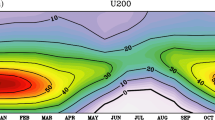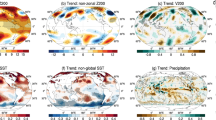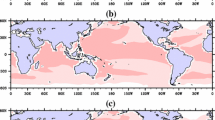Abstract
Purpose of Review
While the influence of climate change on mid-latitude atmospheric circulation remains uncertain, hypotheses based on linear waveguide dynamics have been proposed suggesting amplification of circumglobal quasi-stationary Rossby wave events, which may have led to persistent and high-impact extremes in recent boreal summers. It is thus useful to synthesize these hypotheses and to discuss limitations of this simplified dynamical framework for explaining observed features.
Recent Findings
The hypothesis that climate change can alter the basic circulation state and thereby enhance circumglobal waveguide teleconnections by increasing their resonance has been proposed but has not yet been verified with models. Furthermore, there is no convincing evidence that the variability of disturbances within the waveguide will increase in future climates projected by the CMIP5 models. On the other hand, recent research indicates that enhanced diabatic heating, particularly that associated with increasing aridity in the mid-latitude, can stimulate the jet stream waveguides, thus suggesting an alternative mechanism which, if properly modeled, could lead to more high-amplitude circumglobal planetary wave events.
Summary
There could be circumstances that lead to resonant amplification of waveguide Rossby waves in the boreal summer, but an alternative mechanism that involves changes in the forcing rather than the mean state deserves closer attention.



Similar content being viewed by others
References
Papers of particular interest, published recently, have been highlighted as: • Of importance •• Of major importance
Baker HS, Woollings T, Mbengue C, Allen MR, O’Reilly CH, Shogama H, et al. Forced summer stationary waves: the opposing effects of direct radiative forcing and sea surface warming. Clim Dyn. 2019;53:4291–309. https://doi.org/10.1007/s00382-019-04786-1.
Barnes E, Hartmann D. Dynamical feedbacks and persistence of the NAO. J Atmos Sci. 2010;67:851–65.
Barnes EA, Screen JA. The impact of Arctic warming on the midlatitude jet-stream: can it? Has it? Will it? WIREs Clim Change. 2015;6:277–86. https://doi.org/10.1002/wcc.337.
Barnston AG, Livezey RE. Classification, seasonality and persistence of low-frequency atmospheric circulation patterns. Mon Wea Rev. 1987;115:1083–126.
Beverley JD, Woolnough SJ, Baker LH, Johnson SJ, Weisheimer A. The northern hemisphere circumglobal teleconnection in a seasonal forecast model and its relationship to European summer forecast skill. Clim Dyn. 2019;52:3759–71.
Blackburn M, Methven J, Roberts N. Large-scale context for the UK floods in summer 2007. Weather. 2008;63:280–8.
Branstator G. Horizontal energy propagation in a barotropic atmosphere with meridional and zonal structure. J Atmos Sci. 1983;40:1689–708.
Branstator G. Low-frequency patterns induced by stationary waves. J Atmos Sci. 1990;47:629–49.
Branstator G. Circumglobal teleconnections, the jet stream waveguide, and the North Atlantic oscillation. J Clim. 2002;15:1893–910.
Branstator G. Long-lived response of the midlatitude circulation and storm tracks to pulses of tropical heating. J Clim. 2014;27:8809–26.
Branstator G, Teng H. Tropospheric waveguide teleconnections and their seasonality. J Atmos Sci. 2017;74:1513–32.
Cai M, Mak M. Symbiotic relation between planetary- and synoptic-scale waves. J Atmos Sci. 1990;47:2953–68.
Cassou C, Terray L, Phillips AS. Tropical Atlantic influence on European heat waves. J Clim. 2005;18:2805–11.
Coumou D, Petoukhov V, Rahmstorf S, Petri S, Schellnhuber HJ. Quasi-resonant circulation regimes and hemispheric synchronization of extreme weather in boreal summer. Proc Natl Acad Sci U S A. 2014;111:12331–6.
Coumou D, Lehmann J, Beckmann J. The weakening summer circulation in the northern hemisphere mid-latitudes. Science. 2015;348:324–7.
Coumou D, Capua GD, Vavrus S, Wang L, Wang S. The influence of Arctic amplification on mid-latitude summer circulation. Nat Communication. 2018;9. https://doi.org/10.1038/s41467-018-05256-8.
Di Capua G, Coumou D. Changes in meandering of the Northern Hemisphere circulation. Environ Res Lett. 2016;11:1–9.
Ding Q, Wang B. Circumglobal teleconnection in the Northern Hemisphere summer. J Clim. 2005;18:3483–505.
Ding Q, Wang B. Intraseasonal teleconnection between the summer Eurasian wave Train and the Indian monsoon. J Clim. 2007;20:3751–67.
Ding Q, Wang B, Wallace JM, Branstator G. Tropical–extratropical teleconnections in boreal summer: observed interannual variability. J Clim. 2010;24:1878–96.
Dirmeyer PA. The land surface contribution to the potential predictability of boreal summer season climate. J Hydrometeorol. 2005;6:618–32.
Dirmeyer PA, Koster RD, Guo Z. Do global models properly represent the feedback between land and atmosphere? J Hydrometeorol. 2006;7:1177–98.
Dirmeyer PA, et al. Evidence for enhanced land-atmosphere feedback in a warming climate. J Hydrometeorol. 2012;13:981–95.
Donat MG, Pitman AG, Seneviratne SI. Regional warming of hot extremes accelerated by surface energy fluxes. Geophys Res Lett. 2017;44. https://doi.org/10.1002/2017GL073733.
Donat MG, Pitman AJ, Angelil O. Understanding and reducing future uncertainty in midlatitude daily heat extremes via land surface feedback constraints. Geophy Res Lett. 2018;45. https://doi.org/10.1029/2018GL079128.
Douville H. Influence of soil moisture on the Asian and African monsoon. Part II: Interannual variability J Clim. 2002;15:701–20.
Douville H, Chauvin F. Relevance of soil moisture for seasonal climate predictions: a preliminary study. Clim Dyn. 2000;16:719–36.
Douville H, Plazzotta M. Midlatitude summer drying: an underestimated threat in CMIP5 models? Geophy Res Lett. 2017;44:9967–75.
Douville H, Colin J, Krug E, Cattiaux J, Thao S. Midlatitude daily summer temperature reshaped by soil moisture under climate change. Geophy Res Lett. 2006;43:812–8.
Enomoto T, Hoskins BJ, Matsuda Y. The formation mechanism of the Bonin high in August. Quart J Roy Meteor Soc. 2003;129:157–78.
Fischer EM, Seneviratne SI, Vidale PL, Lüthi D, Schär C. Soil moisture–atmosphere interactions during the 2003 European summer heat wave. J Clim. 2007;20:5081–99.
Fischer EM, Rajczak J, Schär C. Changes in European summer temperature variability revisited. Geophy Res Lett. 2012;39. https://doi.org/10.1029/2012GL052730.
Francis JA, Vavrus SJ. Evidence linking Arctic amplification to extreme weather in mid-latitudes. Geophy Res Lett. 2012;29. https://doi.org/10.1029/2012GL051000.
Fu Q, Feng S. Responses of terrestrial aridity to global warming. J Geophys Res Atmos. 2014;119:7863–75.
Horton RM, Mankin JS, Lesk C, Coffel E, Raymond C. A review of recent advances in research on extreme heat events. Curr Clim Change Rep. 2016;2:242–59.
Hoskins BJ. The potential for skill across the range of the seamless weather-climate prediction problem: a stimulus for our science. Q J R Meteorol Soc. 2012. https://doi.org/10.1002/qj.1991.
Hoskins BJ, Ambrizzi T. Rossby wave propagation on a realistic longitudinally varying flow. J Atmos Sci. 1993;50:1661–71.
Hoskins BJ, Karoly DJ. The steady linear response of a spherical atmosphere to thermal and orographic forcing. J Atmos Sci. 1981;38:1179–96.
Hoskins BJ, Woollings T. Persistent extratropical regimes and climate extremes. Curr Clim Change Rep. 2015;3:115–24.
Huntingford C, Mitchell D, Kornhuber K, Coumou D, Osprey S, Allen M. Assessing changes in risk of amplified planetary waves in a warming world. Atmos Sci Lett. 2018. https://doi.org/10.1002/asl.929.
Jezequel A, et al. Trends of atmospheric circulation during singular hot days in Europe. Environ. Res. Lett. 2018;13. https://doi.org/10.1088/1748-9326.
Kalnay E, et al. The NCEP/NCAR 40-year reanalysis project. Bull Amer Meteor Soc. 1996;77:437–71.
Kay JE, et al. The community earth system model (CESM) large ensemble project: a community resource for studying climate change in the presence of internal climate variability. Bull Amer Mete Soc. 2015;96:1333–49.
Kornhuber K, Petoukhov S, Petri S, Rahmstorf S, Coumou D. Evidence for wave resonance as a key mechanism for generating high-amplitude quasi-stationary waves in boreal summer. Clim Dyn. 2016;49:1961–79.
Kornhuber K, Petoukhov V, Karoly D, Petri S, Rahmstorf S, Coumou D. Summertime planetary wave resonance in the northern and southern hemisphere. J Clim. 2017;30:6133–50.
Kornhuber K, Osprey S, Coumou D, Petri S, Petoukhov V, Rahmstorf S, et al. Extreme weather events in early summer 2018 connected by a recurrent hemispheric wave-7 pattern. Enviro Res Lett. 2019. https://doi.org/10.1088/1748-9326/ab13bf.
Kosaka Y, Nakamura H, Watanabe M, Kimoto M. Analysis on the dynamics of a wave-like teleconnection pattern along the summertime Asian jet based on a reanalysis dataset and climate model simulations. J Mete Soci Japan. 2009;87:561–80.
Koster RD, Dirmeyer PA, Guo Z, Bonan G, Chan E, Cox P, et al. Regions of strong coupling between soil moisture and precipitation. Science. 2004;305:1138–40.
Koster RD, et al. The second phase of global land–atmosphere coupling experiments. Soil moisture contributions to subseasonal forecast skill. J Hydrometeorol. 2011;12:805–22.
Koster RD, Chang Y, Wang H, Schubert SD. Impacts of local soil moisture anomalies on the atmospheric circulation and on remote surface meteorological fields during boreal summers: a comprehensive analysis over North America. J Clim. 2016;29:7345–64.
Koster RD, Betts AK, Dirmeyer PA, Bierkens M, Bennett KE, Déry SJ, et al. Hydroclimate variability and predictability: a survey of recent research. Hydrol Earth Syst Sci. 2017;21:3777–98.
Lee J-Y, Wang B, Seo K-H, Kug J-S, Choi Y-S, Kosaka Y, et al. Future change of Northern Hemisphere summer tropical–extratropical teleconnection in CMIP5 models. J Clim. 2014;27:3643–363.
Lee M-H, Lee S, Song H-J, Ho C-H. The recent increase in the occurrence of a boreal summer teleconnection and its relationship with temperature extremes. J Clim. 2017;30:7493–504.
Lu R, Oh JH, Kim BJ. A teleconnection pattern in upper-level meridional wind over the north African and Eurasian continent in summer. Tellus. 2002;54A:44–55.
Mann ME, Rahmstorf S, Kornhuber K, Steinman BA, Miller SK, Coumou D. Influence of anthropogenic climate change on planetary wave resonance and extreme weather events. Sci Rep. 2017. https://doi.org/10.1038/srep45242.
Mann ME, et al. Projected changes in persistent extreme weather events: the role of quasi-resonant amplification. Sci Adv. 2018. https://doi.org/10.1126/sciadv.aat3272.
Manola I, Selten F, de Vries H, Hazeleger W. “Waveguidability” of idealized jets. J Geophys Res Atmos. 2013;118:10432–40.
Miralles DG, et al. Land–atmospheric feedbacks during droughts and heatwaves: state of the science and current challenges. Ann N Y Acad Sci. 2018. https://doi.org/10.1111/nyas.13912.
Neddermann NC, Müller WA, Dobrynin M, Düsterhus A, Baehr J. Seasonal predictability of European summer climate re-assessed. Clim Dyn. 2019;53:3039–56. https://doi.org/10.1007/s00382-019-04678-4.
O’Reilly CH, Woollings T, Zanna L, Weisheimer A. The impact of tropical precipitation on summertime Euro-Atlantic circulation via a circumglobal wave train. J Clim. 2018;31:6481–504.
Petoukhov V, Rahmstorf S, Petri S, Schellnhuber HJ. Quasiresonant amplification of planetary waves and recent northern hemisphere weather extremes. Proc Natl Acad Sci U S A. 2013a;110:5336–41.
Petoukhov V, Rahmstorf S, Petri S, Schellnhuber HJ. Reply to Screen and Simmonds: from means to mechanisms. Proc Natl Acad Sci U S A. 2013b;110:E2328.
Petoukhov V, Petri S, Rahmstorf S, Coumou D, Kornhuber K, Schellnhuber J. Role of quasiresonant planetary wave dynamics in recent boreal spring-to-autumn extreme events. Proc Natl Acad Sci U S A. 2016;113:6862–7.
Petoukhov V, Petri S, Kornhuber K, Thonicke K, Coumou D, Schellnhuber HJ. Alberta wildfire 2016: apt contribution from anomalous planetary wave dynamics. Sci Rep. 2018;8:12375. https://doi.org/10.1038/s41598-018-30812-z.
Phillips TJ, Gleckler PJ. Evaluation of continental precipitation in 20th century climate simulations: the utility of multimodel statistics. Water Resour Res. 2005;42:W03203. https://doi.org/10.1029/2005WR004313.
Rasmusson EM, Carpenter TH. Variations in tropical sea surface temperature and surface wind fields associated with the Southern Oscillation/El Nino. Mon Wea Rev. 1981;110:354–84.
Rossby CG. Relation between variations in the intensity of the zonal circulation of the atmosphere and displacements of the semi-permanent centers of action. J Mar Res. 1939;2:38–55.
Saeed S, Van Lipzig N, Müller WA, Saeed F, Zanchettin D. Influence of the circumglobal wave-train on European summer precipitation. Clim Dyn. 2014;43:503–15.
Santanello JA, et al. Land–atmosphere interactions: the LoCo perspective. Bull Amer Meteor Soc. 2018. https://doi.org/10.1175/BAMS-D-17-0001.1.
Sardeshmukh PD, Hoskins BJ. The generation of global rotational flow by steady idealized tropical divergence. J Atmos Sci. 1988;45:1228–51.
Schär C, Vidale PL, Lüthi D, Frei C, Haberli C, Liniger MA, et al. The role of increasing temperature variability in European summer heatwaves. Nature. 2004;427:332–6.
Schubert S, Wang H, Suarez M. Warm seasonal subseasonal variability and climate extremes in the northern hemisphere: the role of stationary Rossby waves. J Clim. 2011;24:4773–92.
Schubert S, Wang H, Koster RD, Suarez M, Groisman PY. Northern Eurasian heat waves and droughts. J Clim. 2014;27:3169–207.
Schumacher DL, Keune J, van Heerwaarden CC, de Arellano JV, Teuling AJ, Miralles DG. Amplification of mega-heatwaves through heat torrents fueled by upwind drought. Nature Geo. 2019;12:712–7.
Screen JA, Simmonds I. Caution needed when linking weather extremes to amplified planetary waves. Proc Natl Acad Sci U S A. 2013;110. https://doi.org/10.1073/pnas.1304867110.
Screen JA, Simmonds I. Amplified mid-latitude planetary wave favor particular regional weather extremes. Nat Clim Chang. 2014;4:704–9.
Screen JA, Deser C, Smith DM, Zhang X, Blackport R, Kushner PJ, et al. Consistency and discrepancy in the atmospheric response to Arctic Sea-ice loss across climate models. Nat Geosci. 2018;11:155–63.
Seneviratne SI, et al. Investigating soil moisture–climate interactions in a changing climate: a review. Earth-Sci Rev. 2010;99:125–61.
Seneviratne SI, et al. Impact of soil moisture-climate feedbacks on CMIP5 projections: first results from the GLACE-CMIP5 experiment. Geophy Res Lett. 2013;40:5212–7.
Shaw T. Mechanisms of future predicted changes in the zonal mean mid-latitude circulation. Curr Clim Change Rep, 2019, in press.
Shepherd TG. Atmospheric circulation as a source of uncertainty in climate change projections. Nat Geosci. 2014;7:703–8.
Simpson IR, Shaw TA, Seager R. A diagnosis of the seasonally and longitudinally varying midlatitude circulation response to global warming. J Atmos Sci. 2014;71:2489–515.
Takaya K, Nakamura H. A formulation of a phase-independent wave-activity flux for stationary and migratory quasigeostrophic eddies on a zonally varying basic flow. J Atmos Sci. 2001;58:608–27.
Teng H, Branstator G, Wang H, Meehl GA, Washington WM. Probability of U.S. heat waves affected by a subseasonal planetary wave pattern. Nat. Geosci. 2013;6:1056–61.
Teng H, Branstator G, Meehl GA, Washington WM. Projected intensification of subseasonal temperature variability and heat waves in the Great Plains. Geophys Res Lett. 2016;43:2165–73.
Teng H, Branstator G, Tawfik AB, Callaghan P. Circumglobal response to prescribed soil moisture over North America. J Clim. 2019. https://doi.org/10.1175/JCLI-D-18-0823.1.
Thompson V, Dunstone NJ, Scaife AA, Smith DM, Hardiman SC, Ren H-L, et al. Risk and dynamic of unprecedented hot months in south East China. Clim Dyn. 2019;52:2585–96.
Trenberth KE, Fasullo JT. Climate extremes and climate change: the Russian heat wave and other climate extremes of 2010. J Geophys Res. 2012;117:D17103.
Vavrus S. The influence of Arctic amplification on mid-latitude weather and climate. Curr Clim Change Rep. 2018;4:238–49.
Wallace JM, Gutzler DS. Teleconnections in the geopotential height field during the northern hemisphere winter. Mon Wea Rev. 1981;109:784–812.
Wang S-Y, Hipps LE, Gillies RR, Jiang X, Moller A. Circumglobal teleconnection and early summer rainfall in the US intermountain west. Theor Appl Climatol. 2010;102:245–52.
Wang H, Schubert SD, Koster RD, Change Y. Phase-locking of the boreal summer atmospheric response to dry land surface anomalies in the northern hemisphere. J Clim. 2019;32:1081–99.
Wills RC, White RH, Levine XJ. Northern Hemisphere stationary waves in a changing climate. Curr Clim Change Rep, 2019, in press.
Wolf G, Brayshaw DJ, Klingaman NP, Czaja A. Quasi-stationary waves and their impact on European weather and extreme events. Quart J Roy Meteorol Soc. 2018;144:2431–48.
Woollings T, Barriopedro D, Methven J, Son S-W, Martius O, Harvey B, et al. Blocking and its response to climate change. Curr Clim Change Rep. 2018;3:287–300.
Wulff CO, Greatbatch RJ, Domeisen DI, Gollan G, Hansen F. Tropical forcing of the summer East Atlantic pattern. Geophys Res Lett. 2017. https://doi.org/10.1002/2017GL075493.
Yasui S, Watanabe M. Forcing processes of the summertime circumglobal teleconnection pattern in a dry AGCM. J Clim. 2010;23:2093–114.
Acknowledgments
The authors thank the section editor Dr. Isla Simpson and two anonymous reviewers for constructive reviews. Portions of this study were supported by the Regional and Global Model Analysis (RGMA) component of the Earth and Environmental System Modeling Program of the U.S. Department of Energy’s (DOE) Office of Biological & Environmental Research (BER) Cooperative Agreement no. DE-FC02-97ER62402, and the National Science Foundation (NSF). National Center for Atmospheric Research is sponsored by the NSF.
Author information
Authors and Affiliations
Corresponding author
Ethics declarations
Conflict of Interest
On behalf of both authors, the corresponding author states that there is no conflict of interest.
Additional information
Publisher’s Note
Springer Nature remains neutral with regard to jurisdictional claims in published maps and institutional affiliations.
This article is part of the Topical Collection on Mid-latitude Processes and Climate Change
Rights and permissions
About this article
Cite this article
Teng, H., Branstator, G. Amplification of Waveguide Teleconnections in the Boreal Summer. Curr Clim Change Rep 5, 421–432 (2019). https://doi.org/10.1007/s40641-019-00150-x
Published:
Issue Date:
DOI: https://doi.org/10.1007/s40641-019-00150-x




